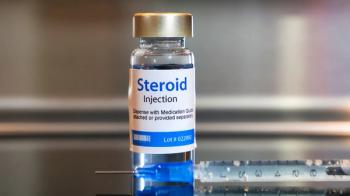
- Vol. 10 No. 9
- Volume 10
- Issue 9
OCT helps diagnose retinoschisis in glaucoma patients
There has recently been much discussion regarding
OCT studies have been become commonplace in the contemporary glaucoma evaluation, and clinicians have relied on OCT for years, both qualitatively and through use normative databases, to diagnose glaucoma and measure its progression.
The peripapillary retina
A recent study by Fortune and colleagues provides an intriguing aspect of OCT studies with respect to glaucoma that may give the clinician another aspect of the eye to consider: the peripapillary retina.2 Parapapillary atrophy has been linked to the presence of glaucoma.3
However, the investigators in this particular study describe the presence of peripapillary retinoschisis as having a potential relationship with faster RNFL and visual field deterioration in glaucoma patients. The relationship between retinoschisis and glaucoma has been demonstrated in other studies in recent history, and it is worthy of our consideration.
Retinoschisis, a condition in which the neurosensory retina splits, has various forms. Areas of peripheral retinoschisis may have little or no symptoms, whereas retinoschisis involving the macula may be visually devastating. Peripapillary retinoschisis, which is around the optic nerve head, would likely be asymptomatic and discovered incidentally by direct visualization or OCT.
Several studies have demonstrated a relationship between peripapillary retinoschisis and glaucoma.4-6 Investigators in the Fortune study used a case control design to analyze longitudinal data from 166 subjects who had been classified as having glaucoma or being glaucoma suspect. Because investigators measured functional markers, patients who were unable to complete visual field studies were excluded.
Of the 166 subjects, 12 eyes were found to have peripapillary retinoschisis, with two eyes exhibiting multiple locations of this finding, giving a total of 15 “retinoschisis events.” The eyes with peripapillary retinoschisis tended to have larger cup-to-disc ratios. These eyes tended to have thinner RNFL measurements as measured by OCT and worse visual fields, as measured by mean deviation. Of significance, age, sex, central corneal thickness, visual acuity, intraocular pressure (IOP), and the presence of vitreous adhesion all failed to predict disparities among those subjects with and without peripapillary retinoschisis.
Müller cell activity
The investigators go further to describe what they purport to be Müller cell activity within the areas of retinoschisis. Müller cells are the glial cells of the retina and are known to exhibit reactive gliosis in the presence of glaucoma.7 This response is an attempt to repair injured neurons and occurs elsewhere in the central nervous system. Such an association makes sense because glaucoma “injures” retinal ganglion cells.
The researchers do well to point out the fact that peripapillary retinoschisis may resolve spontaneously. This point is important to consider with respect to RNFL thinning and glaucoma progression. If an area of retinoschisis involving the RNFL were to resolve, then the measured thickness of the RNFL in that affected area would decrease in value.
By relying on the number of an OCT study, it could be falsely assumed that such a decrease in measured thickness is due to glaucoma progression when, in fact, it may be due to tissue simply returning to its pre-retinoschisis state.
Along those same lines, actual RNFL thinning could potentially be missed if a patient subsequently develops an area of peripapillary retinoschisis (or any condition that may thicken tissue, for that matter). These potential scenarios are two of many numerous reasons why it is important to analyze the entire OCT study and not just “go by the numbers.” Looking at the tomogram itself can yield important qualitative information that may have been otherwise overlooked.
Additional studies are needed to confirm what the investigators of this study have concluded: that peripapillary retinoschisis is associated with a faster glaucoma progression rate and that Müller cells are involved in the pathogenesis of this clinical finding.
The Fortune study points to yet another potential biomarker in the arena of glaucoma progression, and it also does well to instill upon clinicians the importance of paying close attention and using scrutiny when examining OCT studies. All clinicians should avoid mistaking a spontaneously resolving retinal disorder as RNFL thinning. Taking those extra few seconds could potentially change the management of a patient.
References:
1. Frau J, Fenu G, Signori A, Coghe G, Lorefice L, Barracciu MA, Sechi V, Cabras F, Badas M, Marrosu MG, Cocco E.A cross-sectional and longitudinal study evaluating brain volumes, RNFL, and cognitive functions in MS patients and healthy controls. BMC Neurol. 2018 May 11;18(1):67.
2. Fortune B, Ma KN, Gardiner SK, Demirel S, Mansberger SL. Peripapillary Retinoschisis in Glaucoma: Association With Progression and OCT Signs of Müller Cell Involvement. Invest Ophthalmol Vis Sci. 2018 Jun 1;59(7):2818-2827.
3. Skaat A, De Moraes CG, Bowd C, Sample PA, Girkin CA, Medeiros FA, Ritch R, Weinreb RN, Zangwill LM, Liebmann JM; Diagnostic Innovations in Glaucoma Study and African Descent and Glaucoma Evaluation Study Groups. African Descent and Glaucoma Evaluation Study (ADAGES): Racial Differences in Optic Disc Hemorrhage and Beta-Zone Parapapillary Atrophy. Ophthalmology. 2016 Jul;123(7):1476-83.
4. van der Schoot J, Vermeer KA, Lemij HG. Transient Peripapillary Retinoschisis in Glaucomatous Eyes. J Ophthalmol. 2017;2017:1536030.
5. Dhingra N, Manoharan R, Gill S, Nagar M. Peripapillary schisis in open-angle glaucoma. Eye (Lond). 2017 Mar;31(3):499-502.
6. Lee EJ, Kim TW, Kim M, Choi YJ. Peripapillary retinoschisis in glaucomatous eyes. PLoS One. 2014 Feb 28;9(2):e90129.
7. Wang L, Cioffi GA, Cull G, Dong J, Fortune B. Immunohistologic evidence for retinal glial cell changes in human glaucoma. Invest Ophthalmol Vis Sci. 2002 Apr; 43(4): 1088– 1094.
Articles in this issue
about 7 years ago
Vision care back in Kentucky Medicaid mixabout 7 years ago
Why osmolarity should be the top test for tear film evaluationabout 7 years ago
3 strategies to grow your practiceabout 7 years ago
5 tips to impress contact lens patientsabout 7 years ago
View patients as missed opportunity, not lost causeabout 7 years ago
Dry eye protocol for any practiceabout 7 years ago
When to send your hypertensive patient to the ERabout 7 years ago
Highlights of ARVO 2018’s anterior segment postersabout 7 years ago
Know the four stages of dry eye blepharitis syndromeNewsletter
Want more insights like this? Subscribe to Optometry Times and get clinical pearls and practice tips delivered straight to your inbox.













































.png)


